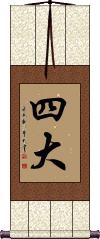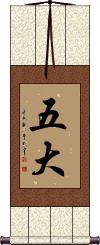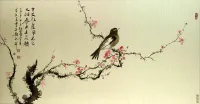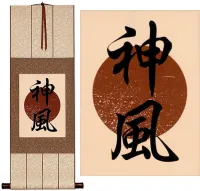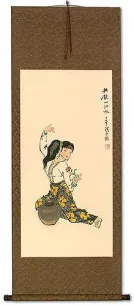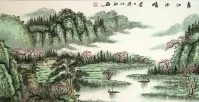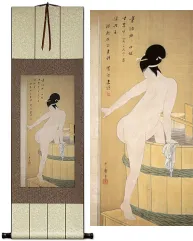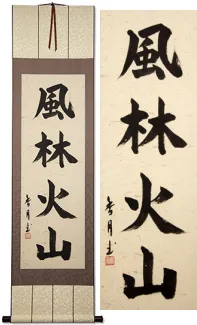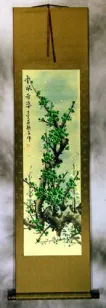Many custom options...
And formats...

Not what you want?
Try other similar-meaning words, fewer words, or just one word.
Earth Wind Fire Water in Chinese / Japanese...
Buy an Earth Wind Fire Water calligraphy wall scroll here!
Personalize your custom “Earth Wind Fire Water” project by clicking the button next to your favorite “Earth Wind Fire Water” title below...
Five Elements
地水火風空 is the specifically-Japanese version of the five elements.
This is a little different than the ancient or original Chinese version.
The elements are written in this order:
1. Earth / Terra / Ground
2. Water
3. Fire
4. Wind / Air
5. Sky / Emptiness / Void / Ether
Note: This set of Kanji can also be romanized as “ji sui ka fuu kuu,” “jisuikafuukuu,” or “jisuikafuku.”
These can also be written in the order 地火風水空 (chi ka sui fuu kuu). Let me know when you place your order if you want the Kanji to be in this character order.
Shidai / Sida / Mahabhuta
In Mahayana Buddhism, 四大 represents mahābhūta, the four elements of which all things are made: earth, water, fire, and wind.
This can also represent the four freedoms: speaking out freely, airing views fully, holding great debates, and writing big-character posters.
In some contexts, this can be a university or college offering four-year programs.
To others, this can represent the Tao, Heaven, Earth, and King.
Going back to the Buddhist context, these four elements “earth, water, fire, and wind,” represent 堅, 濕, 煖, 動, which are: solid, liquid, heat, and motion.
Four Elements
Buddhist Term
地水火風 is a Buddhist term that means “earth, water, fire, wind.”
This is often just referred to as “the four elements.” There is a more common title (the five elements) that adds wood to the mix. These four elements are used in some sects of Japanese Buddhism (not so much in Chinese).
Godai / Five Elements
五大 is the Japanese title for the five elements.
In Japan, the five elements differ slightly from the original Chinese. Therefore, in Japanese philosophy, you have earth, water, fire, wind, and void (space).
The meaning of the first character is 5, but the second character means great or large. Some translate this as the five majors. 大 is only understood as “elements” when you have 五 in front of it.
In Buddhism, this can be short for 五大明王, or the five great and wise kings.
This in-stock artwork might be what you are looking for, and ships right away...
Gallery Price: $322.00
Your Price: $178.88
Gallery Price: $144.00
Your Price: $79.88
Gallery Price: $83.00
Your Price: $45.88
Gallery Price: $240.00
Your Price: $98.88
Gallery Price: $400.00
Your Price: $138.88
Gallery Price: $400.00
Your Price: $138.88
Gallery Price: $108.00
Your Price: $59.88
Gallery Price: $121.00
Your Price: $66.88
Gallery Price: $200.00
Your Price: $122.88
Gallery Price: $72.00
Your Price: $39.88
Not the results for earth wind fire water that you were looking for?
Below are some entries from our dictionary that may match your earth wind fire water search...
| Characters If shown, 2nd row is Simp. Chinese |
Pronunciation Romanization |
Simple Dictionary Definition |
五大 see styles |
wǔ dà wu3 da4 wu ta godai ごだい |
More info & calligraphy: Godai / Five ElementsThe five elements— earth, water, fire, wind, and space. v. also 五行 the five agents. In the esoteric cult the five are the physical manifestation, or garbhadhātu, v. 胎; as being in all phenomena they are called 五輪 the five evolvers; their phonetic embryos 種子 are those of the Five Dhyani-Buddhas of the five directions, v. 五佛. |
四大 see styles |
sì dà si4 da4 ssu ta shidai しだい |
More info & calligraphy: Shidai / Sida / Mahabhuta(1) {Buddh} the four elements (earth, water, fire, wind); (2) the human body; (3) Tao, heaven, earth and king mahābhūta, 四界; 四大界. The four elements of which all things are made; or the four realms; i. e. earth, water, fire, and wind (or air); they represent 堅, 濕, 煖, and 動 solid, liquid, heat, and motion; motion produces and maintains life. As 實 active or formative forces they are styled 四界 (四大界) ; as 假 passive or material objects they are 四大; but the 成實論 Satyasiddhi śāstra disputes the 實 and recognizes only the 假. |
毒蛇 see styles |
dú shé du2 she2 tu she dokuja; dokuhebi どくじゃ; どくへび |
More info & calligraphy: Viperpoisonous snake; poisonous serpent A poisonous snake.; Poisonous snakes, the four elements of the body— earth, water, fire, wind (or air)— which harm a man by their variation, i. e. increase and decrease. Also, gold. |
地水火風 地水火风 see styles |
dì shuǐ huǒ fēng di4 shui3 huo3 feng1 ti shui huo feng chisuikafuu; jisuikafuu / chisuikafu; jisuikafu ちすいかふう; じすいかふう |
More info & calligraphy: Four Elementsearth, water, fire, wind |
地水火風空 see styles |
chisuikafuukuu; jisuikafuukuu / chisuikafuku; jisuikafuku ちすいかふうくう; じすいかふうくう |
More info & calligraphy: Five Elements |
大 see styles |
dài dai4 tai dai だい |
see 大夫[dai4 fu5] (pref,adj-na,n) (1) large; big; great; huge; vast; major; important; serious; severe; (prefix) (2) great; prominent; eminent; distinguished; (suffix) (3) -sized; as big as; the size of; (suffix noun) (4) (abbreviation) (See 大学・1) university; (5) large (e.g. serving size); large option; (6) (abbreviation) (See 大の月) long month (i.e. having 31 days); (given name) Yutaka Maha. 摩訶; 麼賀. Great, large, big; all pervading, all-embracing; numerous 多; surpassing ; mysterious 妙; beyond comprehension 不可思議; omnipresent 體無不在. The elements, or essential things, i.e. (a) 三大 The three all-pervasive qualities of the 眞如 q.v. : its 體, 相 , 用 substance, form, and functions, v. 起信論 . (b) 四大 The four tanmātra or elements, earth, water, fire, air (or wind) of the 倶舍論. (c)五大 The five, i.e. the last four and space 空, v. 大日經. (d) 六大 The six elements, earth, water, fire, wind, space (or ether), mind 識. Hīnayāna, emphasizing impersonality 人空, considers these six as the elements of all sentient beings; Mahāyāna, emphasizing the unreality of all things 法空, counts them as elements, but fluid in a flowing stream of life, with mind 識 dominant; the esoteric sect emphasizing nonproduction, or non-creation, regards them as universal and as the Absolute in differentiation. (e) 七大 The 楞嚴經 adds 見 perception, to the six above named to cover the perceptions of the six organs 根. |
輪 轮 see styles |
lún lun2 lun rin りん |
wheel; disk; ring; steamship; to take turns; to rotate; classifier for big round objects: disk, or recurring events: round, turn (counter) counter for wheels and flowers; (female given name) Run cakra; wheel, disc, rotation, to revolve; v. 研. The three wheels are 惑業苦illusion, karma, suffering, in constant revolution. The five are earth, water, fire, wind, and space; the earth rests on revolving spheres of water, fire, wind, and space. The nine are seen on the tops of pagodas, cf. 九輪.; The two wheels of a cart compared by the Tiantai school to 定 (or to its Tiantai form 止觀) and 慧 meditation and wisdom; see 止觀 5. Also 食 food and 法 the doctrine, i. e. food physical and spiritual. |
七大 see styles |
qī dà qi1 da4 ch`i ta chi ta shichidai |
Earth , water, fire, wind, space (or ether), sight, and perception 地, 水, 火, 風, 空, 見, 証識; cf. 大, 五大and 六境; 見大 and 六根; 識大 and 六識. |
三金 see styles |
sān jīn san1 jin1 san chin mikane みかね |
(surname) Mikane The three metals, gold, silver, copper. The esoterics have (a) earth, water, fire, representing the 身密 mystic body; (b) space and wind, the 語密 mystic mouth or speech; (c) 識 cognition, the 意密 mystic mind. |
五乘 see styles |
wǔ shèng wu3 sheng4 wu sheng gojō |
The five vehicles conveying to the karma reward which differs according to the vehicle: they are generally summed up as (1) 入乘 rebirth among men conveyed by observing the five commandments; (2) 天乘 among the devas by the ten forms of good action; (3) 聲聞乘 among the śrāvakas by the four noble truths; (4) 緣覺乘 among pratyekabuddhas by the twelve nidānas; (5) 菩薩乘 among the Buddhas and bodhisattvas by the six pāramitās 六度 q. v. Another division is the various vehicles of bodhisattvas; pratyekabuddhas; śrāvakas; general; and devas-and-men. Another is Hīnayāna Buddha, pratyekabuddhas, śrāvakas, the gods of the Brahma heavens, and those of the desire-realm. Another is Hīnayāna ordinary disciples: śrāvakas: pratyekabuddhas; bodhisattvas; and the one all-inclusive vehicle. And a sixth, of Tiantai, is for men; devas; śrāvakas-cum-pratyekabuddhas; bodhisattvas: and the Buddha-vehicle. The esoteric cult has: men, corresponding with earth; devas, with water: śrāvakas, with fire: pratyekabuddhas, with wind; and bodhisattvas, with 空 the 'void'. |
五因 see styles |
wǔ yīn wu3 yin1 wu yin goin |
The five causes, v. 倶舍論 7. i. e. (1) 生因 producing cause; (2) 依因supporting cause; (3) 立因 upholding or establishing cause; (4) 持因 maintaining cause; (5) 養因 nourishing or strengthening cause. These all refer to the four elements, earth, water, fire, wind, for they are the causers or producers and maintainers of the infinite forms of nature. Another list from the Nirvana-Sutra 21 is (1) 生因 cause of rebirth, i. e. previous delusion; (2) 和合因 intermingling cause, i. e. good with good, bad with bad, neutral with neutral; (3) 住因 cause of abiding in the present condition, i. e. the self in its attachments; (4) 增長因 causes of development, e. g. food, clothing, etc.; (5) 遠因 remoter cause, the parental seed. |
五智 see styles |
wǔ zhì wu3 zhi4 wu chih gochi ごち |
(place-name, surname) Gochi The five kinds of wisdom of the 眞言宗 Shingon School. Of the six elements 六大 earth, water, fire, air (or wind), ether (or space) 曇空, and consciousness (or mind 識 ), the first five form the phenomenal world, or Garbhadhātu, the womb of all things 胎藏界, the sixth is the conscious, or perceptive, or wisdom world, the Vajradhātu 金剛界, sometimes called the Diamond realm. The two realms are not originally apart, but one, and there is no consciousness without the other five elements. The sixth element, vijñāna, is further subdivided into five called the 五智 Five Wisdoms: (1) 法界體性智 dharmadhātu-prakṛti-jñāna, derived from the amala-vijñāna, or pure 識; it is the wisdom of the embodied nature of the dharmadhātu, defined as the six elements, and is associated with Vairocana 大日, in the centre, who abides in this samādhi; it also corresponds to the ether 空 element. (2) 大圓鏡智 adarśana-jñāna, the great round mirror wisdom, derived from the ālaya-vijñāna, reflecting all things; corresponds to earth, and is associated with Akṣobhya and the east. (3) 平等性智 samatā-jñāna, derived from mano-vijñāna, wisdom in regard to all things equally and universally; corresponds to fire, and is associated with Ratnasaṃbhava and the south. (4) 妙觀察智 pratyavekṣaṇa-jñāna, derived from 意識, wisdom of profound insight, or discrimination, for exposition and doubt-destruction; corresponds to water, and is associated with Amitābha and the west. (5) 成所作智 kṛtyānuṣṭhāna-jñāna, derived from the five senses, the wisdom of perfecting the double work of self-welfare and the welfare of others; corresponds to air 風 and is associated with Amoghasiddhi and the north. These five Dhyāni-Buddhas are the 五智如來. The five kinds of wisdom are the four belonging to every Buddha, of the exoteric cult, to which the esoteric cult adds the first, pure, all-refecting, universal, all-discerning, and all-perfecting. |
五輪 五轮 see styles |
wǔ lún wu3 lun2 wu lun gorin ごりん |
(1) (See オリンピック) Olympic Games; Olympics; (2) Olympic rings; (p,s,f) Gorin The five wheels, or things that turn: I. The 五體 or five members, i. e. the knees, the elbows, and the head; when all are placed on the ground it implies the utmost respect. II. The five foundations of the world. first and lowest the wheel or circle of space; above are those of wind; of water; the diamond, or earth; on these rest the nine concentric circles and eight seas. III. The esoteric sect uses the term for the 五大 five elements, earth, water, fire, wind, and space; also for the 五解脫輪 q. v. IV. The five fingers (of a Buddha). |
六大 see styles |
liù dà liu4 da4 liu ta rokudai ろくだい |
{Buddh} the six elements (earth, water, fire, wind, void, and consciousness); (place-name) Rokudai The six great or fundamental things, or elements — earth; water; fire; wind (or air); space (or ether); and 識 mind, or perception. These are universal and creative of all things, but the inanimate 非情 are made only of the first five, while the animate 有情 are of all six. The esoteric cult represents the six elements, somewhat differently interpreted in the garbhadhātu and vajradhātu. Also 六大界. |
六界 see styles |
liù jiè liu4 jie4 liu chieh rokkai |
The six elements: earth, water, fire, air (or wind), space, and mind; idem 六大. |
四爐 四炉 see styles |
sì lú si4 lu2 ssu lu shiro |
The four furnaces, or altars of the esoteric cult, each differing in shape: earth, square; water, round; fire, triangular; wind, half-moon shape. |
四輪 四轮 see styles |
sì lún si4 lun2 ssu lun yonrin よんりん |
(can be adjective with の) four-wheeled The four wheels or circles: (1) 大地四輪 the four on which the earth rests, wind (or air), water, metal, and space. (2) Four images with wheels, yellow associated with metal or gold, white with water, red with fire, and black with wind. (3) The four dhyāni-buddhas, 金剛輪 Akṣobhya; 寳輪 Ratnasaṃbhava; 法輪 Amitābha; 羯磨輪 Amoghasiddhi. (4) Also the four metals, gold, silver, copper, iron, of the cakravartin kings. |
地大 see styles |
dì dà di4 da4 ti ta chihiro ちひろ |
(personal name) Chihiro Earth as one of the 四大 four elements, 地 earth, 水大 water, 火大 fire, and 風大 air (i. e. air in motion, wind); to these 空大 space (Skt. ākāśa) is added to make the 五大 five elements; 識 vijñāna, perception to make the six elements; and 見 darśana, views, concepts, or reasonings to make the seven elements. The esoteric sect use the five fingers, beginning with the little finger, to symbolize the five elements. |
地輪 地轮 see styles |
dì lún di4 lun2 ti lun jirin |
The earth-wheel, one of the 五輪 five circles, i. e. space, wind, water, earth, and above them fire: the five 'wheels' or umbrellas shown on the top of certain stūpas or pagodas. |
大種 大种 see styles |
dà zhǒng da4 zhong3 ta chung daishu |
The four great seeds, or elements (四大) which enter into all things, i.e. earth, water, fire, and wind, from which, as from seed, all things spring. |
火界 see styles |
huǒ jiè huo3 jie4 huo chieh kakai |
The realm of fire, one of the realms of the four elements 四大, i. e. earth, water, fire, and wind. Cf. 火院. |
空大 see styles |
kōng dà kong1 da4 k`ung ta kung ta takatomo たかとも |
(given name) Takatomo Space, one of the five elements (earth, water, fire, wind, space); v. 五大. |
空界 see styles |
kōng jiè kong1 jie4 k`ung chieh kung chieh kuukai / kukai くうかい |
(personal name) Kuukai The realm of space, one of the six realms, earth, water, fire, wind, space, knowledge. The空界色 is the visible realm of space, the sky, beyond which is real space. |
部多 see styles |
bù duō bu4 duo1 pu to buta |
bhūta, 'been, become, produced, formed, being, existing,' etc. (M. W. ); intp. as the consciously existing; the four great elements, earth, fire, wind, water, as apprehended by touch; also a kind of demon produced by metamorphosis. Also, the 眞如 bhūtatathatā. |
五大形 see styles |
wǔ dà xíng wu3 da4 xing2 wu ta hsing godai gyō |
The symbols of the five elements— earth as square, water round, fire triangular, wind half-moon, and space a combination of the other four. |
五大色 see styles |
wǔ dà sè wu3 da4 se4 wu ta se go daishiki |
The five chief colours— yellow for earth, white for water, red for fire, black for wind, azure for space (or the sky). Some say white for wind and black for water. |
五輪塔 see styles |
gorintou / gorinto ごりんとう |
five-part gravestone representing earth, water, fire, wind and heaven; (place-name) Gorintou |
十二天 see styles |
shí èr tiān shi2 er4 tian1 shih erh t`ien shih erh tien juuniten / juniten じゅうにてん |
twelve devas (esp. of the Shingon sect); (place-name) Jūniten The twelve devas (especially of the Shingon sect): Brahmā; the deva of earth; of the moon; of the sun; Indra; of fire; Yama; of the rakṣas (or demons); of water; of wind; Vaiśramaṇa (wealth); and Maheśvara (Śiva). Also 十二大天衆. |
三密六大 see styles |
sān mì liù dà san1 mi4 liu4 da4 san mi liu ta sanmitsu rokudai |
The three mystic things associated with the six elements, i.e. the mystic body is associated with earth, water, and fire; the mystic words with wind and space; the mystic mind with 識 cognition. |
十一切處 十一切处 see styles |
shí yī qiè chù shi2 yi1 qie4 chu4 shih i ch`ieh ch`u shih i chieh chu jū issai sho |
Ten universals, or modes of contemplating the universe from ten aspects, i.e. from the viewpoint of earth, water, fire, wind blue, yellow, red, white, space, or mind. For example, contemplated under the aspect of water, then the universe is regarded as in flux and change. Also called 十禪支, 十遍處定. It is one of the 三法. |
Click here for more earth wind fire water results from our dictionary
The following table may be helpful for those studying Chinese or Japanese...
| Title | Characters | Romaji (Romanized Japanese) | Various forms of Romanized Chinese | |
| Five Elements | 地水火風空 地水火风空 | chi sui ka fuu kuu chisuikafuukuu chi sui ka fu ku | ||
| Shidai Sida Mahabhuta | 四大 | shi dai / shidai | sì dà / si4 da4 / si da / sida | ssu ta / ssuta |
| Four Elements | 地水火風 地水火风 | chisuikafuu chisuikafu | dì shuǐ huǒ fēng di4 shui3 huo3 feng1 di shui huo feng dishuihuofeng | ti shui huo feng tishuihuofeng |
| Godai Five Elements | 五大 | godai | wǔ dà / wu3 da4 / wu da / wuda | wu ta / wuta |
| In some entries above you will see that characters have different versions above and below a line. In these cases, the characters above the line are Traditional Chinese, while the ones below are Simplified Chinese. | ||||
Successful Chinese Character and Japanese Kanji calligraphy searches within the last few hours...

